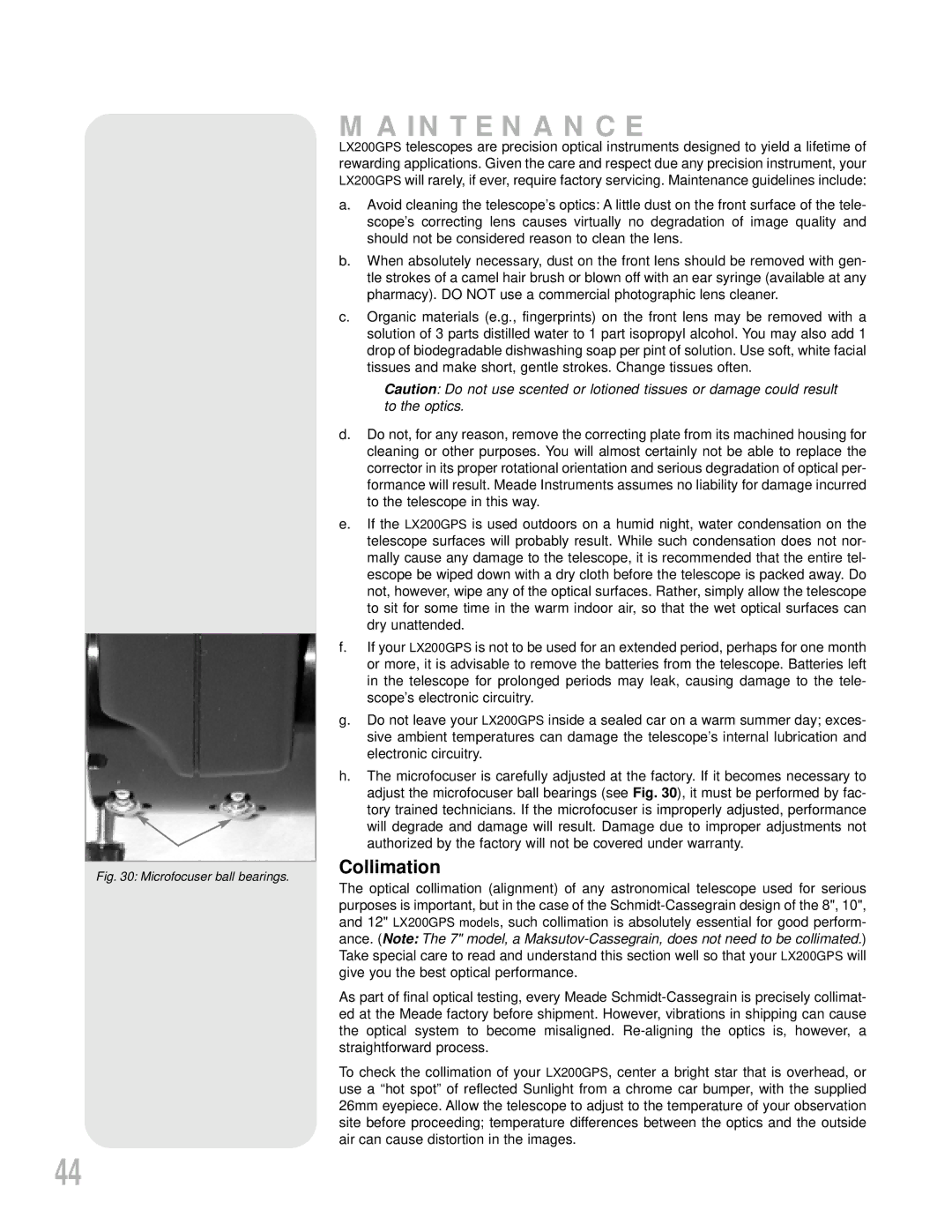
MAINTENANCE
Fig. 30: Microfocuser ball bearings.
LX200GPS telescopes are precision optical instruments designed to yield a lifetime of rewarding applications. Given the care and respect due any precision instrument, your LX200GPS will rarely, if ever, require factory servicing. Maintenance guidelines include:
a.Avoid cleaning the telescope’s optics: A little dust on the front surface of the tele- scope’s correcting lens causes virtually no degradation of image quality and should not be considered reason to clean the lens.
b.When absolutely necessary, dust on the front lens should be removed with gen- tle strokes of a camel hair brush or blown off with an ear syringe (available at any pharmacy). DO NOT use a commercial photographic lens cleaner.
c.Organic materials (e.g., fingerprints) on the front lens may be removed with a solution of 3 parts distilled water to 1 part isopropyl alcohol. You may also add 1 drop of biodegradable dishwashing soap per pint of solution. Use soft, white facial tissues and make short, gentle strokes. Change tissues often.
Caution: Do not use scented or lotioned tissues or damage could result to the optics.
d.Do not, for any reason, remove the correcting plate from its machined housing for cleaning or other purposes. You will almost certainly not be able to replace the corrector in its proper rotational orientation and serious degradation of optical per- formance will result. Meade Instruments assumes no liability for damage incurred to the telescope in this way.
e.If the LX200GPS is used outdoors on a humid night, water condensation on the telescope surfaces will probably result. While such condensation does not nor- mally cause any damage to the telescope, it is recommended that the entire tel- escope be wiped down with a dry cloth before the telescope is packed away. Do not, however, wipe any of the optical surfaces. Rather, simply allow the telescope to sit for some time in the warm indoor air, so that the wet optical surfaces can dry unattended.
f.If your LX200GPS is not to be used for an extended period, perhaps for one month or more, it is advisable to remove the batteries from the telescope. Batteries left in the telescope for prolonged periods may leak, causing damage to the tele- scope’s electronic circuitry.
g.Do not leave your LX200GPS inside a sealed car on a warm summer day; exces- sive ambient temperatures can damage the telescope’s internal lubrication and electronic circuitry.
h.The microfocuser is carefully adjusted at the factory. If it becomes necessary to adjust the microfocuser ball bearings (see Fig. 30), it must be performed by fac- tory trained technicians. If the microfocuser is improperly adjusted, performance will degrade and damage will result. Damage due to improper adjustments not authorized by the factory will not be covered under warranty.
Collimation
The optical collimation (alignment) of any astronomical telescope used for serious purposes is important, but in the case of the
As part of final optical testing, every Meade
To check the collimation of your LX200GPS, center a bright star that is overhead, or use a “hot spot” of reflected Sunlight from a chrome car bumper, with the supplied 26mm eyepiece. Allow the telescope to adjust to the temperature of your observation site before proceeding; temperature differences between the optics and the outside air can cause distortion in the images.
44
